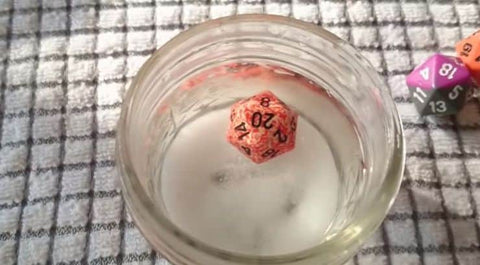There are a lot of different styles and designs of dice out there, from simply solid-colored polyhedral to convoluted interlocking panels that you shift and twist, to rings that you can wear on your fingers. Many of these dice market themselves as being “perfectly balanced”, and some even “precision balanced”. Many of these styles, too, are not truly “game legal” – meaning you might not be allowed to use them when playing in Adventurer’s League tournaments or more professionally run games. This is because certain brands and types of dice are more or less likely to be accurately balanced.
Whether a die is balanced refers to whether the likelihood that a player will roll each side of the dice is even, and doesn’t favor a certain number or group of numbers.
Essentially, balanced dice are fair dice.
Are My Dice Balanced?

It can be easy to assume that all dice sold for gaming are balanced (with the exception of intentionally unbalanced dice, of course). In reality, dice, especially many-sided ones, have a lot of opportunities to be slightly off-balance.
The material can settle oddly to one side or the other, making that side heavier and therefore the dice on those sides appear less often. Cheap, solid dice are prone to this, since they are often filled with cork-like material that can be denser in one side or another. Resin and acrylic dice are slightly more resistant, but can still have the problem, too. Of course, dice with stuff inside them (like glitter, miniature figures, or sequins) are also likely to have more weight in the places where the inserts are, since these things are likely heavier than the resin itself.
Or, the edges of the dice might be slightly uneven, and alter their roll. This can even happen over time to balanced dice, if the edges get slightly chipped or dented. This is just normal wear-and-tear on dice.
How to Test A Die’s Balance
There are a few standard ways to check whether your dice are balanced, but unfortunately none of them are terribly easy. Neither are they terribly specific – they’ll tell you if your dice is badly misaligned, but generally not small imperfections or disbalance.
They are as follows:
Visual Balance Check

The first is to look for obvious flaws or damage to the dice. If it’s missing chunks (old sets that came with early editions are prone to this), it’s probably unbalanced. Of course, it’s not likely that you’re seriously using these damaged dice anyway, since they tend to be hard to read.
Other cues like internal items, obviously incorrect shapes, or infilled numbers are a giveaway as well.
Manual Balance Check
This method takes a while, but can be done without any mess or fuss, and is probably the most accurate. You just roll the die a bunch of times (at least 50-100), record each result, and calculate how often each result appears. If a die is balanced, it should be approximately the same frequency for each number.
The formula to calculate this should be: (# of times a result appears/total # of rolls)
Each result should appear around:
For d20s: 5% of the time
For d12s: 8.33% of the time
For d10s: 10% of the time
For d8s: 12.5% of the time
For d6s: 16.67% of the time
For d4s: 25% of the time
Of course, actual rolls aren’t likely to line up exactly with their probabilities, even if it is balanced. Probably represents the amount each result would appear if the die was roll an infinite number of times, and real-life chance really does give randomized, rather than perfectly spread, results. You’re just looking for ballparks.
Water Balance Test
This test is a favorite, but it can be tricky to get right. It works extremely well to check for internal weight imbalances, especially in cheap, cork-filled dice.
Take a glass of water, and mix in a liberal amount of salt (this will make it easier to float your dice). Then, place your die carefully in the cup, and use your finger to spin it several times to see what number is on the surface of the water. If a die is improperly weighted, the heavier side will face the bottom more often than normal rolling will reveal.

If the readable results are an assortment of numbers, you should be good to go!
Does it Matter if My Dice are Perfectly Balanced?
As stated above, the previous methods of balance testing aren’t foolproof. They can tell you if your dice are drastically off, but not slightly unbalanced. The only way to really be certain that you’re getting perfectly balanced dice is to go in for precision sets.

And, really, that’s okay. If your dice aren’t unbalanced enough to be noticeable, they probably aren’t unbalanced enough to disrupt your game.
The more balanced the dice, the more truly random your rolls, and the more “fair” the game is. But slight variations between dice aren’t the end of the world, so long as they aren’t giving you a drastic advantage or disadvantage from the other players’ rolls.
Those “absolutely perfectly precision balanced” dice sets are cool, and if you like them, by all means use them! But they aren’t necessary to play the game. Fate seems to overpower error with surprising frequency.





